Nature | Letter
Social learning promotes institutions for governing the commons
- Journal name:
- Nature
- Volume:
- 466,
- Pages:
- 861–863
- Date published:
- (12 August 2010)
- DOI:
- doi:10.1038/nature09203
- Received
- Accepted
- Published online
Theoretical and empirical research highlights the role of punishment in promoting collaborative efforts1, 2, 3, 4, 5. However, both the emergence and the stability of costly punishment are problematic issues. It is not clear how punishers can invade a society of defectors by social learning or natural selection, or how second-order free-riders (who contribute to the joint effort but not to the sanctions) can be prevented from drifting into a coercion-based regime and subverting cooperation. Here we compare the prevailing model of peer-punishment6, 7, 8 with pool-punishment, which consists in committing resources, before the collaborative effort, to prepare sanctions against free-riders. Pool-punishment facilitates the sanctioning of second-order free-riders, because these are exposed even if everyone contributes to the common good. In the absence of such second-order punishment, peer-punishers do better than pool-punishers; but with second-order punishment, the situation is reversed. Efficiency is traded for stability. Neither other-regarding tendencies or preferences for reciprocity and equity, nor group selection or prescriptions from higher authorities, are necessary for the emergence and stability of rudimentary forms of sanctioning institutions regulating common pool resources and enforcing collaborative efforts.
Subject terms:
Figures at a glance
-
Figure 1: Time evolution of the competition between peer-punishment and pool-punishment. 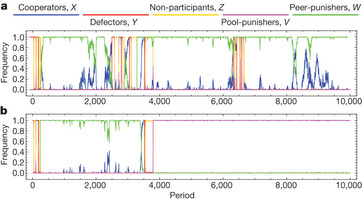
Two typical individual-based simulation runs, without (a) and with (b) second-order punishment. In a, peer-punishers prevail most of the time, but sometimes second-order free-riders invade. In this case, defectors and then non-participants take over before peer-punishment is re-established. In b, pool-punishers eventually establish a very stable regime. Parameters: N = 5, r = 3, c = 1, σ = 1, γ = β = 0.7, B = G = 0.7, M = 100 and μ = 10−3. The updating is by strong imitation (s
 +∞);
that is, players with lower average pay-off always imitate players with
higher average pay-off. The initial population consists of defectors
only.
+∞);
that is, players with lower average pay-off always imitate players with
higher average pay-off. The initial population consists of defectors
only. -
Figure 2: Pool-punishment in compulsory and voluntary PGGs. 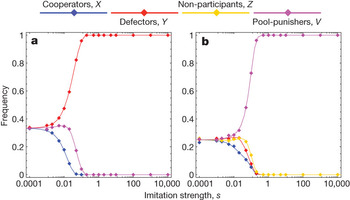
Results of extensive simulations based on social learning (Supplementary Information). To obtain reliable average frequencies, each player updates 107 times. Data points are supported by analytical approximations (solid lines). Parameters are as in Fig. 1, but with μ = 10−6 and with variable imitation strength, s. For small s values, updating is mostly random and frequencies of all strategies are roughly equal. Discrimination between strategies increases with s. a, Compulsory PGGs lead for larger s values to a regime of defectors. b, In voluntary PGGs, the cycle X
 Y
Y  Z
Z  X
provides an escape from of the defectors’ regime through recurrent
opportunities to establish a sanctioning system with second-order
punishment.
X
provides an escape from of the defectors’ regime through recurrent
opportunities to establish a sanctioning system with second-order
punishment. -
Figure 3: The competition between peer- and pool-punishers in voluntary PGGs. 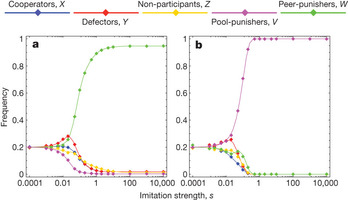
References
- & Cooperation and punishment in public good experiments. Am. Econ. Rev. 90, 980–994 (2000)
- & The efficient interaction of indirect reciprocity and costly punishment. Nature 444, 718–723 (2006)
- , & The long-run benefits of punishment. Science 322, 1510–1512 (2008)
- et al. Costly punishment across human societies. Science 312, 1767–1770 (2006)
- , & Antisocial punishment across societies. Science 319, 1362–1367 (2008)
- & Altruistic punishment in humans. Nature 415, 137–140 (2002)
- & Cooperation and punishment, especially in humans. Am. Nat. 164, 753–764 (2004)
- & The economics of altruistic punishment and the maintenance of cooperation. Proc. R. Soc. B 275, 871–878 (2008)
- & Detrimental effects of sanctions on human altruism. Nature 422, 137–140 (2003)
- , , & The evolution of altruistic punishment. Proc. Natl Acad. Sci. USA 100, 3531–3535 (2003)
- Altruistic punishment and the origin of cooperation. Proc. Natl Acad. Sci. USA 102, 7047–7049 (2005)
- & The evolution of altruism and punishment: role of the selfish punisher. J. Theor. Biol. 240, 475–488 (2006)
- , , & Strong reciprocity or strong ferocity? A population genetic view of the evolution of altruistic punishment. Am. Nat. 170, 21–36 (2007)
- & Punishment allows the evolution of cooperation (or anything else) in sizable groups. Ethol. Sociobiol. 13, 171–195 (1992)
- The provision of a sanctioning system as a public good. J. Pers. Soc. Psychol. 51, 110–116 (1986)
- Governing the Commons: The Evolution of Institutions for Collective Action (Cambridge Univ. Press, 1990)
- , , & &. Sigmund, K. Via freedom to coercion: the emergence of costly punishment. Science 316, 1905–1907 (2007)
- & The Major Transitions in Evolution (Oxford Univ. Press, 1997)
- Mutual policing and repression of competition in the evolution of cooperative groups. Nature 377, 520–522 (1995)
- (ed.) Games, Groups, and the Global Good (Springer, 2009)
- , & in The Drama of the Commons (eds Ostrom, L. et al.) 157–191 (National Academy, 2002)
- & When does optional participation allow the evolution of cooperation? Proc. R. Soc. B 276, 1167–1174 (2009)
- , & Coordinated punishment of defectors sustains cooperation and can proliferate when rare. Science 328, 617–620 (2010)
- & Social welfare, cooperator’s advantage, and the option of not playing the game. Am. Sociol. Rev. 58, 787–800 (1993)
- , , & Volunteering as a Red Queen mechanism for cooperation. Science 296, 1129–1132 (2002)
- , & Volunteering leads to rock–paper–scissors dynamics in a public goods game. Nature 425, 390–393 (2003)
- , , & Second order punishment in one-shot prisoner’s dilemma. Int. J. Psychol. 39, 329–334 (2004)
- , & The competitive advantage of sanctioning institutions. Science 312, 108–111 (2006)
- , & Who to punish? Individual decisions and majority rule in mitigating the free rider problem. Eur. Econ. Rev. 53, 495–511 (2009)
- , & Institution formation in public goods games. Am. Econ. Rev. 99, 1335–1355 (2009)
Acknowledgements
K.S. acknowledges TECT I-104 G15, A.T. thanks the Emmy Noether programme of the DFG and C.H. thanks NSERC (Canada).
Supplementary information
PDF files
- Supplementary Information (217K)
This file contains Supplementary Methods, Supplementary Figure 1 with legend, Supplementary Data and References.



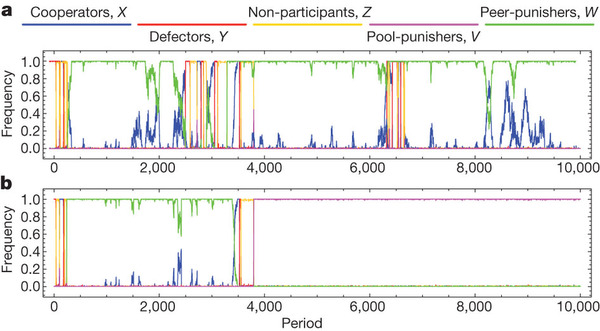

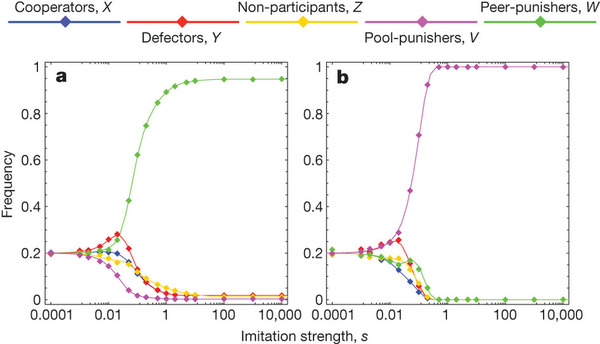








Comments
There are currently no comments.
Subscribe to comments
Add your comment
This is a public forum. Please keep to our Community Guidelines. You can be controversial, but please don't get personal or offensive and do keep it brief. Remember our threads are for feedback and discussion - not for publishing papers, press releases or advertisements. If you find something abusive or inappropriate or which does not otherwise comply with our Terms or Community Guidelines, please select the relevant 'Report this comment' link.
You need to be registered with Nature and agree to our Community Guidelines to leave a comment. Please log in or register as a new user. You will be re-directed back to this page.